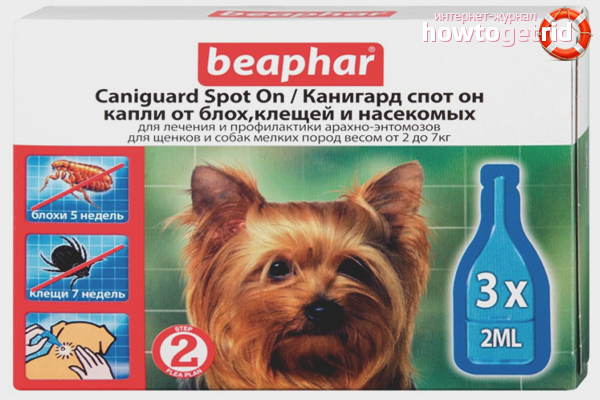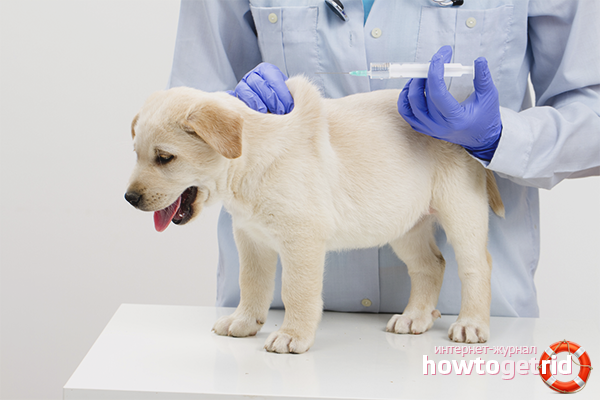The content of the article
Ticks make themselves felt in the spring when the first snow melts and the weather rises above zero. Blood-sucking insects affect the human nervous system (encephalitis), and the four-legged friends develop a disease of the circulatory system. Many dog owners are seriously thinking about security measures, and this is not surprising. Every owner wants to protect his ward from the dangerous effects of a bite. Consider the most effective ways to solve the problem.
Method number 1. Tick collar
- One of the surest and available methods of dealing with ticks is acaricidal collar. The device is impregnated with a special liquid with insecticidal properties.
- The principle of operation and use is not particularly difficult.The owner needs to unpack the ribbon, put the collar on the pet and fit it.
- Ammunition of this kind does not protect the animal from ticks by 100%, many manufacturers give a guarantee of only 90%. For this reason, the collar must be supplemented with other, more effective means.
- Collars are designed to combat surface parasites, not subcutaneous. Before use, it is necessary to study the duration of action. Thus you can replace the old ammunition in time.
- In addition to protection against ticks, the collar effectively copes with fleas and lice. The duration of the last two types of insects is much longer.
- Impregnation, located in the cavity of the material is released during the process of wearing. The composition covers the skin and coat of the animal, remaining in the structure for a long time. Ticks often affect the ears, withers, neck, chest and head. The collar is aimed specifically at designated areas.
- From the drawbacks of the devices can be identified insecurity of the abdomen, the back of the body, tail. It is not uncommon for a pet to develop an allergy to the drug.
- Owners of two or more dogs should abandon the collar.Fellows can lick each other, causing a harmful substance to fall into the mouth. It is also worth being careful with families with small children.
- Prefer drops of leading manufacturers. These include Front Line, Strong Hold, Dana, Bars, Adventig Baer, Chistotel. Pick up ammunition taking into account the age of the pet and the duration of the action.
Method number 2. Tick drops
- Many breeders prefer drugs in the form of drops, and this is not surprising. The effective composition gives a 100% guarantee. To process a pet, you must purchase the composition in pipettes. Then the fur is spreading in the area of the withers, neck and behind the ears.
- The drug is poured onto the skin and rubbed. Drops begin to act after the day after treatment. A positive characteristic of this kind of composition is considered to be complete protection from subcutaneous and external parasites, as well as mosquitoes.
- Today, there are many types of drops. They vary in price, manufacturer, duration of action, composition. Choose products necessarily taking into account the age of the animal.Many drops can only be used after six months.
- Dog handlers trust domestic and foreign manufacturers. These include the Russian companies Dana, Bars and Chistotel, the French company Frontline, the German manufacturer Bayer, the American products Strong Hold and FiproGard Sentry.
- The principle of the droplets is simple: after application, they are distributed in the coat, fur follicles and pet sebaceous glands. Chemicals do not penetrate the blood of the animal, do not cause poisoning. However, this aspect does not relieve allergies (in rare cases).
- Choose products taking into account the individual characteristics of your pet. Pregnant, lactating and elderly individuals, as well as puppies and dogs of small breeds need to buy drops marked "Eco".
- If several pets live at the same time in the house, after processing, do not let them lick each other. Isolate the treated individual for 24 hours from their relatives. Wool should dry, and drops - soak.
- Choose the composition by age and weight parameters, as well as the type of breed (small, medium, large group).People with dogs weighing up to 3 kg should especially approach the process.
- After treatment, do not bathe the dog for 3 days, so as not to reduce the effectiveness of the drug. As a rule, the pipette lasts for a month. It is applied to the wool in one step. Do not forget to re-process in time.
- Before you buy, check the expiration date. Expired products will not protect the animal from blood-sucking insects. If the selected product was ineffective, go to a different composition and manufacturer.
Method number 3. Mite shampoo
- Woolen cleaners often contain acaricides, repellents and insecticides. The listed components provide protection against ticks for up to 1 week. Shampoo is used as an auxiliary, with a non-basic composition.
- As a rule, owners of small dogs resort to cleaning products with a tick mark. Miniature breeds spend a lot of time on the hands of the owner and lead a home life. For this reason, they do not always need long-term protection.
- Shampoos should be used if you go out of town or on vacation, where the terrain is saturated with ticks. Do not shampoo the dog, which has recently been treated with drops.
- Do not rely on shampoos alone. Use additional methods of protection to prevent infection of your pet. Do not bathe the dog if it is wearing a parasite collar.
Method number 4. Mite spray
- Sprays are very popular with owners of large breed dogs. The bottle allows you to spray the drug on the entire body of the dog, providing full protection of the tail, abdomen, hind legs, croup and, of course, the front area.
- This method is worth resorting to owners whose pets spend a lot of time in nature (hunting, guard or service individuals). You cannot protect the animal better than the spray does.
- Difficulties with the use should not arise, but some features are still there. Spray the product in the open air, each time raising the wool. Do not go home until the fur dries.
- The negative characteristics include the toxicity of the composition and high pricing. Cover your airways before spraying, as well as your pet's nose and mouth.
- Before direct application, read the manufacturer's recommendations. Pay special attention to the sections "Contraindications" and "Use".As a rule, these areas have a long list of activities.
Method number 5. Tick tablets
- The innovation in the care of four-legged friends struck dog handlers and dog owners. To date, this tool is considered the most popular and effective tablets give a 100% guarantee.
- The drug is available in the form of a pressed composition with flavors. You can treat your favorite pill with sausage, chicken or pork. The dog will swallow the medicine and become invulnerable.
- The composition is mixed with plasma and spreads with blood, circulating in the body over a long period. In addition to the destruction of external parasites, the drug protects the dog from other pathogens.
- A positive aspect of the drug is considered relatively sparing and universal composition. Tablets are allowed to feed elderly dogs, lactating and pregnant females, puppies (at their onset of three months of age).
- To date, there are 2 types of tablets from ticks - "Bravekto" and "Front Line". The Austrian company "Bravekto" creates drugs with the active ingredient fluralaner.One reception is enough for 3 months, the composition is calculated taking into account body weight.
- Front Line Nex-Gard (France) is more popular with Russian dog owners. The drug allows you to protect a pet for up to 4 weeks. Tablets are contraindicated in allergy sufferers.
Method number 6. Mite vaccination
- You can protect your pet with vaccines. In veterinary clinics provide vaccine "Pirodog" from the company "Merial", France. The composition allows you to protect your pet from piroplasmosis.
- The effectiveness of the procedure ranges from 75-85%. You can vaccinate when the puppy is 5 months old. In this case, the pet must be vaccinated against viruses and proglythogonally.
- The vaccination procedure is carried out in 2 stages with a break of 1 month. Repeated course runs after a year or six months, depending on the habitat.
- Vaccination and revaccination is strictly prohibited to combine with vaccinations of a different kind. The exception is protection against rabies and leptospirosis.
- If the dog previously suffered from piroplasmosis and is its chronic carrier, the virus can break out again. In this case, it is necessary to treat the pet in a standard way, and also treat it with drops.
How to protect a dog from ticks by folk methods
- Geranium. If you keep a pet in the private sector, as a result of which the pet often walks in the yard, proceed as follows. Plant marigolds or geraniums (pink) on the plot. The result of such actions will be the complete absence of ticks. Bloodsucking are afraid of unpleasant smell. As a supplement, you can dry the plants, make a decoction of them and rinse the hair of the animal.
- Tar soap. The product is considered an analogue of tick shampoos. Using soap will not protect the dog for a long time, but will save the result for up to 2 weeks. Well soap the animal, wait 5 minutes, rinse. Prepare in advance for the unpleasant smell that will emanate from pet hair.
- Esters Fragrant oils scare ticks, pests do not come close to the dog a single step. Prepare the ether of lemon balm, tea tree, lavender, geranium, citrus fruits or cloves. Connect the composition with filtered water and vodka, observing the ratio of 1: 10: 1. Transfer the solution to the vial, spray it over the pet's coat and allow it to dry. Pay due attention to the tail, withers, abdomen, paws and neck.If desired, spray the collar.
It is easy to protect a four-legged friend from ticks, if you have basic knowledge. The most effective means are drops and pills. Spray is in second place, but it is toxic. Shampoo and collar are used as additional protection. Vaccination is carried out to increase the effectiveness of these compounds.
Video: how to protect a dog from ticks






 2 votes, on average: 4,00 out of 5
2 votes, on average: 4,00 out of 5







To send
To protect the dog from ticks, it must be treated with special means. For this, there are drops and collars and I heard the sprays even appeared.